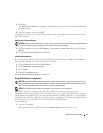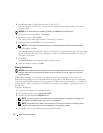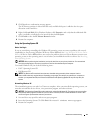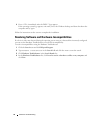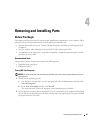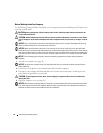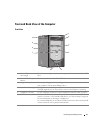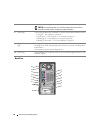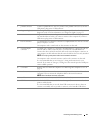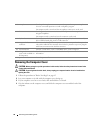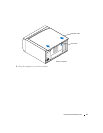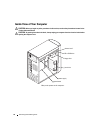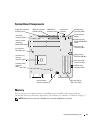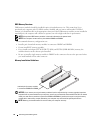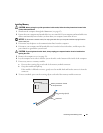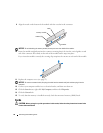
Removing and Installing Parts 49
1 parallel connector Connect a parallel device, such as a printer, to the parallel connector. If you have a
USB printer, plug it into a USB connector.
2 diagnostic lights (4) Use the lights to help you troubleshoot a computer problem based on the
diagnostic code. For more information, see "Diagnostic Lights" on page 33.
3 mouse connector Plug a standard mouse into the green mouse connector. Turn off the computer and
any attached devices before you connect a mouse to the computer. If you have a
USB mouse, plug it into a USB connector.
4 line-in connector Use the blue line-in connector to attach a record/playback device such as a cassette
player, CD player, or VCR.
On computers with a sound card, use the connector on the card.
5 network adapter
connector
To attach your computer to a network or broadband device, connect one end of a
network cable to either a network jack or your network or broadband device.
Connect the other end of the network cable to the network adapter connector on
your computer. A click indicates that the network cable has been securely attached.
NOTE: Do not plug a telephone cable into the network connector.
On computers with a network connector card, use the connector on the card.
It is recommended that you use Category 5 wiring and connectors for your
network. If you must use Category 3 wiring, force the network speed to 10 Mbps to
ensure reliable operation.
6 cover latch Releases the cover from the computer. See "Removing the Computer Cover" on
page 50.
7
modem connector (Optional) If you have a modem, connect a telephone cable to either of the modem
connectors. Do not connect the telephone cable to the network connector.
NOTE: Not all modems have two connectors.
8 card slots Access connectors for any installed PCI cards (three slots).
9 USB 2.0 connectors (4) Use the back USB connectors for devices that typically remain connected, such as
printers and keyboards.
It is recommended that you use the front USB connectors for devices that you
connect occasionally, such as joysticks or cameras, or for bootable USB devices.



